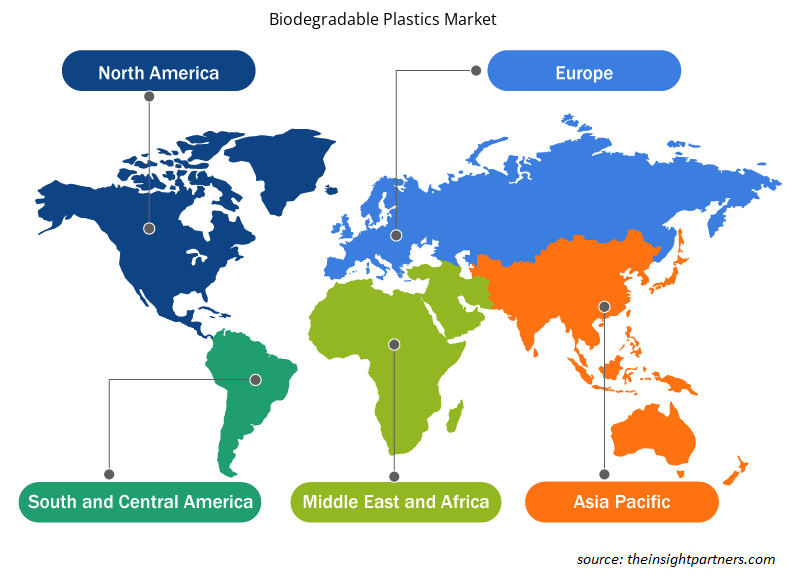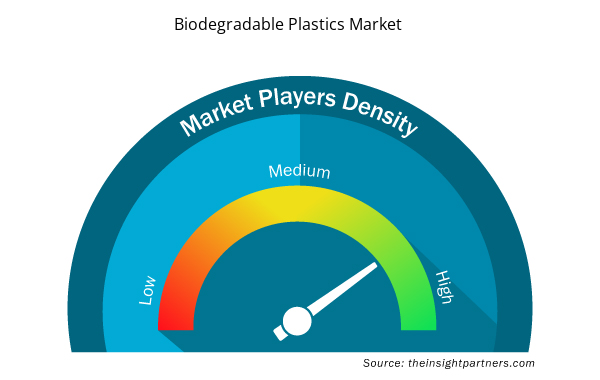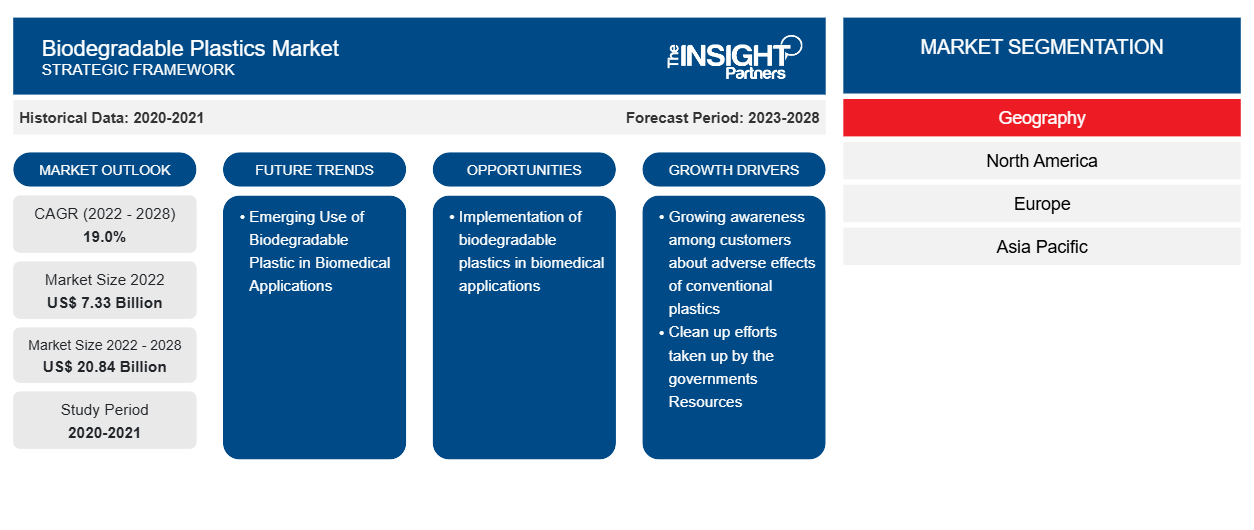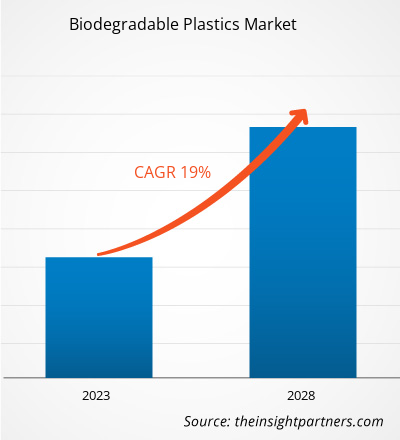[تقرير بحثي] من المتوقع أن ينمو حجم سوق البلاستيك القابل للتحلل الحيوي من 7،331.11 مليون دولار أمريكي في عام 2022 إلى 20،840.29 مليون دولار أمريكي بحلول عام 2028؛ ومن المتوقع أن يسجل معدل نمو سنوي مركب بنسبة 19.0٪ من عام 2022 إلى عام 2028.
تحليل السوق
يمكن تحلل البلاستيك القابل للتحلل البيولوجي بشكل طبيعي في البيئة من خلال عمل الكائنات الحية، وعادة ما تكون الميكروبات، إلى الماء وثاني أكسيد الكربون والكتلة الحيوية. ويمكن تصنيعه باستخدام مواد خام متجددة وكائنات دقيقة وبتروكيماويات. وهي مصممة للتحول إلى معادن في بيئة خاضعة لإدارة النفايات كما توفر بديلاً فعالاً وصديقًا للبيئة للبوليمرات الاصطناعية. بذلت الهيئات الحكومية والشركات المصنعة في جميع أنحاء العالم جهودًا لتحسين كفاءة إعادة تدوير النفايات البلاستيكية وإعادة تدويرها. ومن المتوقع أن يؤدي الوعي المتزايد بين العملاء حول الآثار الضارة للبلاستيك التقليدي إلى تعزيز الطلب على المنتج.
محركات النمو والتحديات
لقد تم تثقيف العملاء في البلدان المتقدمة والنامية بشأن الآثار السيئة للبلاستيك التقليدي على نمط حياتهم والبيئة. ونتيجة لذلك، فإنهم يطالبون بمنتجات أكثر صداقة للبيئة، مما يؤدي إلى انخفاض في استخدام النفط الخام والغاز الطبيعي، مما يؤدي إلى تقليل البصمة الكربونية. يعد البلاستيك القابل للتحلل الحيوي بديلاً لجميع البلاستيك التقليدي المستخدم في مجموعة متنوعة من التطبيقات. تقدم هذه البلاستيكات بدائل مبتكرة بخصائص محسنة، إلى جانب القدرة المميزة على تقليل الانبعاثات بالإضافة إلى توفير نفس الصفات والوظائف مثل البلاستيك التقليدي. يتم تصنيع البلاستيك القابل للتحلل الحيوي باستخدام موارد متجددة بالإضافة إلى المواد الخام الأحفورية، مثل إستر السليلوز، وPLA، وPHA، ومشتقات النشا، والبوليستر المشترك. تشارك العديد من المنظمات في إحداث تحول في التعامل مع البلاستيك، من خلال التخطيط الاستراتيجي، والاتصال، وحملات توعية المستهلك، والأفلام الوثائقية، والتعليم، وحملات التنظيف، وزيادة الوعي التجاري، والبحث العلمي، والابتكار الريادي، والتشريعات، والاستدامة. الهدف الرئيسي هو تثقيف المستخدمين فيما يتعلق بتلوث البلاستيك، وبالتالي تشجيع اختراع حلول أكثر استدامة، وتمكين المزيد من الأشخاص والمؤسسات التجارية من اتخاذ إجراءات لوقف تلوث البلاستيك. لذلك، فإن الثورة في الطلب الاستهلاكي على أساس الوعي البيئي، وراحة التعبئة والتغليف، وأنظمة إنتاج البلاستيك المستدامة تعمل على تعزيز نمو سوق البلاستيك القابل للتحلل.
قم بتخصيص هذا التقرير ليناسب متطلباتك
ستحصل على تخصيص لأي تقرير - مجانًا - بما في ذلك أجزاء من هذا التقرير، أو تحليل على مستوى الدولة، وحزمة بيانات Excel، بالإضافة إلى الاستفادة من العروض والخصومات الرائعة للشركات الناشئة والجامعات
- احصل على أهم اتجاهات السوق الرئيسية لهذا التقرير.ستتضمن هذه العينة المجانية تحليلاً للبيانات، بدءًا من اتجاهات السوق وحتى التقديرات والتوقعات.
تقسيم التقرير ونطاقه
"تحليل سوق البلاستيك القابل للتحلل الحيوي العالمي حتى عام 2030" هو دراسة متخصصة ومتعمقة مع التركيز الرئيسي على اتجاهات السوق العالمية وفرص النمو. يهدف التقرير إلى تقديم نظرة عامة على السوق العالمية مع تقسيم السوق التفصيلي حسب النوع والمستخدم النهائي والجغرافيا. شهد سوق البلاستيك القابل للتحلل الحيوي العالمي نموًا مرتفعًا خلال الماضي القريب ومن المتوقع أن يستمر هذا الاتجاه خلال فترة التنبؤ. يقدم التقرير إحصائيات رئيسية عن استهلاك البلاستيك القابل للتحلل الحيوي في جميع أنحاء العالم جنبًا إلى جنب مع الطلب عليه في المناطق والبلدان الرئيسية. بالإضافة إلى ذلك، يقدم التقرير التقييم النوعي للعوامل المختلفة التي تؤثر على أداء سوق البلاستيك القابل للتحلل الحيوي في المناطق والبلدان الرئيسية. يتضمن التقرير أيضًا تحليلًا شاملاً للاعبين الرائدين في سوق البلاستيك القابل للتحلل الحيوي وتطوراتهم الاستراتيجية الرئيسية. يتم أيضًا تضمين العديد من التحليلات حول ديناميكيات السوق للمساعدة في تحديد العوامل الدافعة الرئيسية واتجاهات السوق والفرص المربحة التي من شأنها بدورها أن تساعد في تحديد جيوب الإيرادات الرئيسية.
علاوة على ذلك، يوفر تحليل النظام البيئي وتحليل القوى الخمس لبورتر رؤية بزاوية 360 درجة لسوق البلاستيك القابل للتحلل الحيوي العالمي، مما يساعد على فهم سلسلة التوريد بأكملها والعوامل المختلفة التي تؤثر على نمو السوق.
التحليل القطاعي
يتم تقسيم سوق البلاستيك القابل للتحلل الحيوي العالمي على أساس النوع والمستخدم النهائي. بناءً على النوع، يتم تقسيم سوق البلاستيك القابل للتحلل الحيوي إلى PLA وPHA ومزائج النشا وPBS وPBAT وغيرها. على أساس المستخدم النهائي، يتم تصنيف السوق على أنها التعبئة والتغليف والحقائب والزراعة والبستنة والسلع الاستهلاكية وغيرها. بناءً على النوع، شكلت مزائج النشا حصة كبيرة. النشا هو بوليمر طبيعي موجود في نباتات مثل الذرة والأرز والبطاطس في شكل حبيبات غير قابلة للذوبان في الماء. تلقى النشا اهتمامًا متزايدًا كمادة خام لإنتاج الأفلام بسبب نقص توافر الراتنجات التقليدية المكونة للأفلام. تنتمي بولي هيدروكسي ألكانوات (PHA) إلى عائلة البوليمرات الطبيعية. وجد PHA مكانًا حيويًا في التطبيقات الطبية نظرًا لتوافقه الحيوي. تتميز هذه المادة بمقاومة جيدة للأشعة فوق البنفسجية ولكنها تقاوم الأحماض والقواعد بشكل ضعيف كما أنها قابلة للذوبان في الكلوروفورم والهيدروكربونات المكلورة الأخرى. ومن المعروف أن PBS تتحلل بشكل طبيعي في الماء وثاني أكسيد الكربون. كما تستخدم على نطاق واسع في تصنيع أفلام التغليف والصناديق وكذلك في تغليف مستحضرات التجميل. واستنادًا إلى المستخدم النهائي، شكلت شريحة التغليف والحقائب حصة كبيرة. وقد وجدت المواد البلاستيكية القابلة للتحلل الحيوي مكانة حيوية في قطاع التغليف والحقائب نظرًا لخصائصها مثل قوة الشد العالية وسهولة الاستخدام مقارنة بالبلاستيك التقليدي. ويؤدي الطلب المتزايد على التغليف الغذائي الصديق للبيئة إلى تحويل تركيز الشركات المصنعة للبوليمرات وشركات التغليف إلى البلاستيك القابل للتحلل. وقد تم تضمين استخدام البلاستيك المستدام في الحياة اليومية في تصنيع السلع الاستهلاكية بما في ذلك الألعاب والأمشاط ومقابض الأدوات والسلع الأخرى. وقد وجدت بوليمرات PLA وPHA تطبيقات واسعة النطاق في إنتاج الألعاب. وقد نفذت شركة Italeri، إحدى شركات تصنيع الألعاب الإيطالية الرائدة، استخدام بلاستيك PHA وPLA لإنتاج الألعاب.
التحليل الإقليمي
يقدم التقرير نظرة عامة مفصلة على سوق البلاستيك القابل للتحلل الحيوي العالمي فيما يتعلق بخمس مناطق رئيسية، وهي؛ أمريكا الشمالية وأوروبا وآسيا والمحيط الهادئ (APAC) والشرق الأوسط وأفريقيا (MEA) وأمريكا الجنوبية والوسطى. استحوذت أوروبا على حصة كبيرة من السوق وبلغت قيمتها أكثر من 2600 مليون دولار أمريكي في عام 2022. ويعزى هذا الهيمنة إلى المخاوف البيئية المتزايدة بين المستهلكين والاعتماد المتزايد على البلاستيك القابل للتحلل الحيوي نظرًا لطبيعته الصديقة للبيئة. علاوة على ذلك، فإن اللوائح الصارمة المفروضة على شريط البلاستيك للاستخدام الفردي إلى جانب المبادرات الحكومية نحو اعتماد التغليف القابل لإعادة التدوير ستدفع حجم الصناعة الإقليمية. ومن المتوقع أيضًا أن تشهد أمريكا الشمالية نموًا كبيرًا تقدر قيمته بحوالي 4900 مليون دولار أمريكي في عام 2028، ويعزى ذلك إلى زيادة الوعي بين الناس بالمنتجات الصديقة للبيئة. يدفع الوعي المتزايد بالاحتباس الحراري والتلوث البلاستيكي المستهلكين إلى اختيار التغليف الصديق للبيئة. تنمو منطقة آسيا والمحيط الهادئ بشكل كبير بمعدل نمو سنوي مركب يزيد عن 20.5٪. وقد ثبت أن العدد المتزايد من الحظر المفروض على المواد البلاستيكية التقليدية هو المحرك الأساسي لنمو هذه السوق. فضلاً عن ذلك، فإن الطلب المتزايد على مواد التغليف المرنة من صناعة السلع الاستهلاكية وتبني العديد من الابتكارات التكنولوجية في مجال التغليف من شأنه أن يعزز النمو الإقليمي.CAGR with more than 20.5%. The rising number of bans on traditional plastics proves to be the primary driver for the growth of this market. Besides, the growing demand for flexible packaging from the consumer goods industry and the adoption of various technological innovations in packaging will boost the regional growth.
تطورات الصناعة والفرص المستقبلية
يقدم التقرير نظرة عامة مفصلة على سوق البلاستيك القابل للتحلل الحيوي العالمي فيما يتعلق بخمس مناطق رئيسية، وهي؛ أمريكا الشمالية، وأوروبا، وآسيا والمحيط الهادئ (APAC)، والشرق الأوسط وأفريقيا (MEA) وأمريكا الجنوبية والوسطى.
في عام 2022، أعلنت شركة كانيكا عن استثمار 15 مليار ين ياباني لزيادة قدرتها الإنتاجية لبوليمر كانيكا القابل للتحلل الحيوي جرين بلانيت في اليابان. ويهدف الاستثمار إلى زيادة القدرة الإنتاجية من 5000 طن متري إلى حوالي 20000 طن متري سنويًا، ومن المقرر أن تبدأ العمليات في يناير 2024.
في عام 2021، أعلنت مجموعة SK التي تتخذ من كوريا الجنوبية مقراً لها، عن تشكيل شراكة استراتيجية مع شركة التجارة المحلية LX International وشركة الأغذية Daesang لإطلاق مشروع مشترك لإنتاج PBAT باستثمار بقيمة 151.3 مليون دولار أمريكي.
رؤى إقليمية حول سوق البلاستيك القابل للتحلل الحيوي
لقد قام المحللون في Insight Partners بشرح الاتجاهات والعوامل الإقليمية المؤثرة على سوق البلاستيك القابل للتحلل الحيوي طوال فترة التوقعات بشكل شامل. يناقش هذا القسم أيضًا قطاعات سوق البلاستيك القابل للتحلل الحيوي والجغرافيا في جميع أنحاء أمريكا الشمالية وأوروبا ومنطقة آسيا والمحيط الهادئ والشرق الأوسط وأفريقيا وأمريكا الجنوبية والوسطى.

- احصل على البيانات الإقليمية المحددة لسوق البلاستيك القابل للتحلل
نطاق تقرير سوق البلاستيك القابل للتحلل الحيوي
| سمة التقرير | تفاصيل |
|---|---|
| حجم السوق في عام 2022 | 7.33 مليار دولار أمريكي |
| حجم السوق بحلول عام 2028 | 20.84 مليار دولار أمريكي |
| معدل النمو السنوي المركب العالمي (2022 - 2028) | 19.0% |
| البيانات التاريخية | 2020-2021 |
| فترة التنبؤ | 2023-2028 |
| المناطق والدول المغطاة | أمريكا الشمالية
|
| قادة السوق وملفات تعريف الشركات الرئيسية |
|
كثافة اللاعبين في السوق: فهم تأثيرها على ديناميكيات الأعمال
يشهد سوق البلاستيك القابل للتحلل الحيوي نموًا سريعًا، مدفوعًا بالطلب المتزايد من المستخدم النهائي بسبب عوامل مثل تفضيلات المستهلكين المتطورة والتقدم التكنولوجي والوعي المتزايد بفوائد المنتج. ومع ارتفاع الطلب، تعمل الشركات على توسيع عروضها والابتكار لتلبية احتياجات المستهلكين والاستفادة من الاتجاهات الناشئة، مما يؤدي إلى زيادة نمو السوق.
تشير كثافة اللاعبين في السوق إلى توزيع الشركات أو المؤسسات العاملة في سوق أو صناعة معينة. وهي تشير إلى عدد المنافسين (اللاعبين في السوق) الموجودين في مساحة سوق معينة نسبة إلى حجمها أو قيمتها السوقية الإجمالية.
الشركات الرئيسية العاملة في سوق البلاستيك القابل للتحلل هي:
- باسف اس اي
- نوفامونت اس بي ايه
- نيتشر ووركس ذ.م.م
- شركة ميتسوبيشي للكيماويات
- إجمالي كوربيون PLA
إخلاء المسؤولية : الشركات المذكورة أعلاه ليست مرتبة بأي ترتيب معين.

- احصل على نظرة عامة على أهم اللاعبين الرئيسيين في سوق البلاستيك القابل للتحلل الحيوي
تأثير كوفيد/ تأثير السيناريو الجيوسياسي/ تأثير الركود
يقدم التقرير نظرة عامة مفصلة على سوق البلاستيك القابل للتحلل الحيوي العالمي فيما يتعلق بخمس مناطق رئيسية، وهي؛ أمريكا الشمالية وأوروبا وآسيا والمحيط الهادئ (APAC) والشرق الأوسط وأفريقيا (MEA) وأمريكا الجنوبية والوسطى. كانت الصناعات مثل التعبئة والتغليف والحقائب والزراعة والبستنة والسلع الاستهلاكية والسيارات هي المستهلكين الرئيسيين للبلاستيك القابل للتحلل الحيوي. في عام 2020، اضطرت هذه الصناعات إلى إبطاء عملياتها بسبب الاضطرابات في سلسلة القيمة الناجمة عن إغلاق الحدود الوطنية والدولية. علاوة على ذلك، أعاقت عمليات الإغلاق التي فرضتها دول مختلفة قدرة الصناعات على الحفاظ على مستويات المخزون في نفس العام. كما أحدث الوباء دمارًا في صناعة السيارات والسلع الاستهلاكية. أدى نقص القوى العاملة إلى تباطؤ عمليات إنتاج وتوزيع البلاستيك القابل للتحلل الحيوي. بالإضافة إلى ذلك، أدت القيود الحكومية وغيرها من احتياطات COVID-19 إلى تقليل القدرات الإنتاجية لمصنعي البلاستيك القابل للتحلل الحيوي في سلسلة القيمة. في عام 2021، بدأ السوق العالمي في التعافي من الخسائر التي تكبدها في عام 2020، حيث أعلنت حكومات بلدان مختلفة عن تخفيف القيود الاجتماعية. وعلاوة على ذلك، أدى الحظر الحكومي المتزايد على المواد البلاستيكية التي تُستخدم مرة واحدة، وتوسع القدرات الإنتاجية في صناعة الزراعة وتعبئة الأغذية والمشروبات في مناطق مختلفة من العالم إلى زيادة الطلب على المواد البلاستيكية القابلة للتحلل البيولوجي في عام 2021.
المشهد التنافسي والشركات الرئيسية
تشمل بعض اللاعبين الرئيسيين العاملين في سوق البلاستيك القابل للتحلل البيولوجي، BASF SE، وFKuR Kunststoff GmbH، وGreen Dot Bioplastics Inc، وNovamont SpA، وKingfa Science and Technology Co Ltd، وNatureWorks LLC، وMitsubishi Chemical Holdings Corp، وPlantic Technologies Ltd، وTotalEnergies Corbion BV، وAPI SpA، من بين آخرين.
- التحليل التاريخي (سنتان)، السنة الأساسية، التوقعات (7 سنوات) مع معدل النمو السنوي المركب
- تحليل PEST و SWOT
- حجم السوق والقيمة / الحجم - عالميًا وإقليميًا وقطريًا
- الصناعة والمنافسة
- مجموعة بيانات Excel



Report Coverage
Revenue forecast, Company Analysis, Industry landscape, Growth factors, and Trends

Segment Covered
This text is related
to segments covered.

Regional Scope
North America, Europe, Asia Pacific, Middle East & Africa, South & Central America

Country Scope
This text is related
to country scope.
الأسئلة الشائعة
Growing awareness among customers about adverse effects of conventional plastics, and supportive government policies for eco-friendly products and biodegradable plastics are some of the key driving factors for the biodegradable plastics market.
Based on the type, the starch blends segment accounted for the largest revenue share. Starch has been receiving growing attention as raw material for the production of films due to the lack of the availability of the conventional film-forming resins. Therefore, this factor is expected to boost the starch blends’ segment, leading to largest revenue share.
The utilization of biodegradable plastics in biomedical applications, is expected to provide lucrative growth opportunities to the global biodegradable plastics market during the forecast period.
The major players operating in the global biodegradable plastics market are BASF SE; Novamont SpA; NatureWorks LLC; Mitsubishi Chemical Corporation; Total Corbion PLA; amongst others.
Europe biodegradable plastics market is expected to surge as strict government legislations are limiting the utilization of customary plastics. Therefore, several FMCG companies are adopting biodegradable packaging so to conform to the standards, which in turn, is propelling the growth of this market. Therefore, Europe accounts for the largest share of the global biodegradable plastics market.
Based on end-user, consumer goods is the fastest-growing segment. The utilization of biodegradable plastics in consumer goods on a large scale globally due to high tensile strength, transparency, and other mechanical properties, is driving the segment’s growth.
The List of Companies - Biodegradable Plastics Market
- BASF SE
- Novamont SpA
- NatureWorks LLC
- Mitsubishi Chemical Corporation
- Total Corbion PLA
- Plantic Technologies Limited
- Kingfa Sci. & Tech. Co., Ltd
- Green Dot Bioplastics
- FKuR Kunststoff GmbH
- API SpA
The Insight Partners performs research in 4 major stages: Data Collection & Secondary Research, Primary Research, Data Analysis and Data Triangulation & Final Review.
- Data Collection and Secondary Research:
As a market research and consulting firm operating from a decade, we have published and advised several client across the globe. First step for any study will start with an assessment of currently available data and insights from existing reports. Further, historical and current market information is collected from Investor Presentations, Annual Reports, SEC Filings, etc., and other information related to company’s performance and market positioning are gathered from Paid Databases (Factiva, Hoovers, and Reuters) and various other publications available in public domain.
Several associations trade associates, technical forums, institutes, societies and organization are accessed to gain technical as well as market related insights through their publications such as research papers, blogs and press releases related to the studies are referred to get cues about the market. Further, white papers, journals, magazines, and other news articles published in last 3 years are scrutinized and analyzed to understand the current market trends.
- Primary Research:
The primarily interview analysis comprise of data obtained from industry participants interview and answers to survey questions gathered by in-house primary team.
For primary research, interviews are conducted with industry experts/CEOs/Marketing Managers/VPs/Subject Matter Experts from both demand and supply side to get a 360-degree view of the market. The primary team conducts several interviews based on the complexity of the markets to understand the various market trends and dynamics which makes research more credible and precise.
A typical research interview fulfils the following functions:
- Provides first-hand information on the market size, market trends, growth trends, competitive landscape, and outlook
- Validates and strengthens in-house secondary research findings
- Develops the analysis team’s expertise and market understanding
Primary research involves email interactions and telephone interviews for each market, category, segment, and sub-segment across geographies. The participants who typically take part in such a process include, but are not limited to:
- Industry participants: VPs, business development managers, market intelligence managers and national sales managers
- Outside experts: Valuation experts, research analysts and key opinion leaders specializing in the electronics and semiconductor industry.
Below is the breakup of our primary respondents by company, designation, and region:

Once we receive the confirmation from primary research sources or primary respondents, we finalize the base year market estimation and forecast the data as per the macroeconomic and microeconomic factors assessed during data collection.
- Data Analysis:
Once data is validated through both secondary as well as primary respondents, we finalize the market estimations by hypothesis formulation and factor analysis at regional and country level.
- Macro-Economic Factor Analysis:
We analyse macroeconomic indicators such the gross domestic product (GDP), increase in the demand for goods and services across industries, technological advancement, regional economic growth, governmental policies, the influence of COVID-19, PEST analysis, and other aspects. This analysis aids in setting benchmarks for various nations/regions and approximating market splits. Additionally, the general trend of the aforementioned components aid in determining the market's development possibilities.
- Country Level Data:
Various factors that are especially aligned to the country are taken into account to determine the market size for a certain area and country, including the presence of vendors, such as headquarters and offices, the country's GDP, demand patterns, and industry growth. To comprehend the market dynamics for the nation, a number of growth variables, inhibitors, application areas, and current market trends are researched. The aforementioned elements aid in determining the country's overall market's growth potential.
- Company Profile:
The “Table of Contents” is formulated by listing and analyzing more than 25 - 30 companies operating in the market ecosystem across geographies. However, we profile only 10 companies as a standard practice in our syndicate reports. These 10 companies comprise leading, emerging, and regional players. Nonetheless, our analysis is not restricted to the 10 listed companies, we also analyze other companies present in the market to develop a holistic view and understand the prevailing trends. The “Company Profiles” section in the report covers key facts, business description, products & services, financial information, SWOT analysis, and key developments. The financial information presented is extracted from the annual reports and official documents of the publicly listed companies. Upon collecting the information for the sections of respective companies, we verify them via various primary sources and then compile the data in respective company profiles. The company level information helps us in deriving the base number as well as in forecasting the market size.
- Developing Base Number:
Aggregation of sales statistics (2020-2022) and macro-economic factor, and other secondary and primary research insights are utilized to arrive at base number and related market shares for 2022. The data gaps are identified in this step and relevant market data is analyzed, collected from paid primary interviews or databases. On finalizing the base year market size, forecasts are developed on the basis of macro-economic, industry and market growth factors and company level analysis.
- Data Triangulation and Final Review:
The market findings and base year market size calculations are validated from supply as well as demand side. Demand side validations are based on macro-economic factor analysis and benchmarks for respective regions and countries. In case of supply side validations, revenues of major companies are estimated (in case not available) based on industry benchmark, approximate number of employees, product portfolio, and primary interviews revenues are gathered. Further revenue from target product/service segment is assessed to avoid overshooting of market statistics. In case of heavy deviations between supply and demand side values, all thes steps are repeated to achieve synchronization.
We follow an iterative model, wherein we share our research findings with Subject Matter Experts (SME’s) and Key Opinion Leaders (KOLs) until consensus view of the market is not formulated – this model negates any drastic deviation in the opinions of experts. Only validated and universally acceptable research findings are quoted in our reports.
We have important check points that we use to validate our research findings – which we call – data triangulation, where we validate the information, we generate from secondary sources with primary interviews and then we re-validate with our internal data bases and Subject matter experts. This comprehensive model enables us to deliver high quality, reliable data in shortest possible time.


 احصل على عينة مجانية لهذا التقرير
احصل على عينة مجانية لهذا التقرير